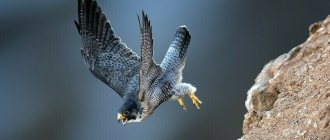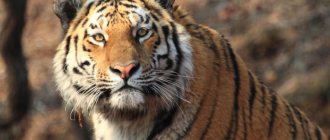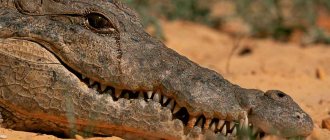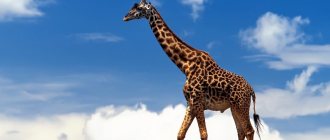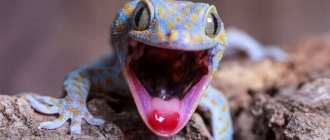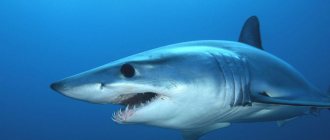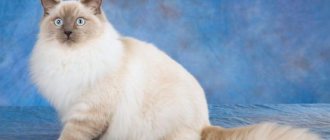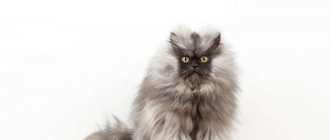Dune cat
The sand cat is the smallest representative of wild cats, and therefore is often endangered by other predators. Capable of chasing prey at a speed of 40 km/h for 10 km.
Egyptian Mau
Although the Egyptian Mau has long been domesticated, the wild nature of the cat still takes over. From the time when her ancestors had to hunt for survival, Mau learned to run at a speed of 58 km/h.
Leopard
For him, high speed is not particularly important, since he does not hunt on the ground. This spotted wild cat prefers to watch for prey, hiding in the foliage of trees, and overtake it with one sharp jump. He has strong muscular legs, and his running speed can reach 60 km/h.
Tiger
A very large cat, capable of chasing prey at speeds of 60 km/h. But a weight of more than 300 kg and a 3-meter body length often interfere with successful hunting.
Puma
Like the lion, its close relative is large in size, but is capable of maintaining a speed of 75 km/h. This gives the puma an advantage during hunting, but its large dimensions do not allow it to maintain speed for a long time.
Snow Leopard
The handsome snow leopard can only be found high in the mountains. He not only runs fast, but also jumps. The length of his jump can be 6 meters and the height - 3 meters. In terms of running speed, the leopard is not inferior to the lion, while the animal’s long tail acts as a steering wheel and helps to turn in different directions.
a lion
The king of beasts is a fairly large animal with a body weight of more than 2 centners. Therefore, it is difficult for him to maintain high speed over long distances. At a speed of about 80 km/hour, a lion can run no more than 20 meters. When hunting, this predator prefers to lie in wait for its prey and pounce on it.
Panther
The panther is not only fast, but also the most dexterous and dangerous predator.
This wild cat is unusually graceful and, unlike its counterparts, hunts near human settlements. The black beauty is capable of running at a speed of 88 km/h and is particularly bloodthirsty. The objects of her hunt can be not only animals, but also humans.
Jaguar
This animal can move at a speed of 90 km/hour. Jaguars are large. The body, without a tail, can reach a length of more than 2 meters. Because of their size, it is quite difficult for them to pursue prey at high speed for a long time.
Cheetah
Considered the fastest animal on Earth. A wild cat has a powerful, muscular body without an ounce of excess fat. The weight of a cheetah is 70 kg, and the speed that the animal develops exceeds 110 km/h.
The predator will not sit in ambush and guard the prey. The cheetah needs a few tugs and the prey will be in its claws. Just two seconds are enough for this “savage” to develop lightning speed, and the length of the jump can reach 8 meters.
Fifth place – Snow Leopard
The animal has a second name - snow leopard (snow cat). The predator is considered rare and incredibly beautiful. He is capable of running a short distance at speeds of up to 80 km/h . The leopard jumps far - 6 meters in length.
The predator has short but incredibly powerful legs with developed muscles. The tail helps change direction when running. This is convenient during hunting, because the prey does not have a chance.
Characteristics of the snow leopard:
- Length – up to 2.3 meters.
- Weight – up to 55 kg.
- Life expectancy in the natural environment is 13 years, in captivity – 21 years.
I recommend: Rare cat breeds: TOP 19
The snow leopard is the highest mountain animal on Earth. It can be found at an altitude of up to 6 km above sea level.
Tiger
The tiger has also long been on the list of the fastest representatives among predatory cats. At short distances, it is capable of reaching speeds of up to 60 km/h. Just imagine that in pursuit of a victim they will be able to jump 5-6 meters in length (and in height, by the way, too).
But, even despite these physical abilities, not every tiger hunt is successful. These cats are very massive, their weight can increase up to 300 kg, and their body length (excluding the tail) can vary up to three meters. That is why, despite their physical dominance, they are significantly inferior to the cheetah in speed.
Leopard
The puma (or mountain lion) consistently occupies sixth position in the world top of the fastest cats. These predators reach speeds of up to 75 km/h over short distances.
Recommend: What are the most beautiful cat breeds in the world?
These large animals reach two meters in length (including tail). The weight of these cats reaches 100 kg. A well-developed muscular system and low weight contribute to the speed and agility of mountain lions. They can accelerate to 75 km/h.
Females are smaller in size than males. But, at the same time, they are not inferior to them in agility and speed.
MegaMix
Domestic cats run somewhat slower than homeless cats, for whom speed and lightning speed of reaction are a way of survival. But even at home, they need active movement, so even without visible danger, the cat likes to stretch its muscles, rushing from room to room. In such games, she seems to be chasing imaginary prey. The average speed of the animal, regardless of its habitat, is 13.86 m/s. Even the most unprepared cat runs much faster than a human thanks to a special running technique.
Maximum and average speed
| average speed | Maximum speed | |
| 13.86 m/s | 50 km/h | up to 58 km/h (home) |
In case of danger, she lunges, arches her back and makes jumps that exceed the length of her own body up to 6 times. The front and hind legs work in pairs. When jerking, the animal pushes off the surface with its hind legs, landing first on the front, then on the back pair of legs. When walking leisurely, a cat steps on the pads, but when running, the cat's claws extend outward, which provides better traction on the surface for effective pushing.
Features of running cats and cats of different breeds
Maine Coon cats use their fluffy tail, which has strong muscles at the base, to regulate speed. The bobtail cat breed cannot boast of a powerful tail, as this limb is practically absent. They develop high speed thanks to their high and strong hind legs. This variety is considered one of the most energetic cat breeds; the bobtail needs long active games and requires an equally active lifestyle of the owner.
The leader in terms of speed among domestic cats is the Egyptian Mau breed. At the base of their hind legs they have folds of skin in the form of small bags. The resulting step reserve allows the cat to have a particularly wide range of motion when running and, therefore, to run faster than its relatives from other breeds.
The cat is the victim, the cat is the hunter
Since cats do not occupy a dominant position in the food chain, in the wild they often find themselves in the role of prey and her life depends on how quickly she manages to escape. In its own hunt, this small predator usually focuses on surprise and dexterity of the paws, rather than speed. Having previously hidden and accurately calculated its death-carrying throw, a cat is able to catch a mouse or bird even in flight.
Speed is an advantage, but not an option
However, with all its sprinting qualities, which allow the cat to reach speeds of up to 50 km/h, the cat’s heart is not able to withstand prolonged stress. After a long run at high speed, the cat is forced to stop to normalize its body temperature and breathing. Therefore, when the pursuit is too long, the animal will have to give up. A cat driven by a pack of dogs is doomed to death if it has nowhere to hide.
In urban conditions, where there is not always a suitable tree to climb and avoid danger, these animals die more often than in rural areas.
The fastest wild cat breeds
The cat family includes 41 species of wild cats. They all vary in size, color and behavior. And among them we can single out the fastest.
Cheetah and jaguar
In appearance, cheetahs resemble the graceful Russian greyhound. Like these dogs, cheetahs have blunt claws that hardly retract, they also do not climb trees well, they prefer to stalk their prey rather than sit in ambush, and they never feed on carrion.
The jaguar's body length can reach up to 180 cm in length, and its weight can be more than 90 kg. It is very similar to a leopard in its appearance, but is much larger in size.
Panther and lion
the lion is called the “king of beasts.” The weight of individual individuals can be above 250 kg. It is noteworthy that, despite all their external greatness, lions cannot be classified as especially hardy animals.
Recommend: What breeds of cats do not shed or smell?
Snow leopard and puma
The snow leopard has adapted to live in the harsh conditions of the highlands. The highest point at which a snow leopard was spotted is 6 km above sea level.
Springbok (88 km/h)
Springbok
The Springbok is the national animal of the Republic of South Africa and lives on open savannas. In fact, this is not just a small antelope that can run very fast, but an artiodactyl with an incredible ability to make three-meter jumps in the air in case of danger. Springbok reaches a speed of more than 85 km per hour, and the body is approximately one and a half meters long, their height ranges from 70 to 90 cm. The weight of this mammal is insignificant - on average 30 kg.
Gentle, purring creatures. How to choose just such a cat
In fact, the secret is simple: the most affectionate cats only come from loving owners. If you give an animal your tenderness and care day after day, then it will answer you in kind. Cats are quite vindictive; once strongly offended, she will look at you for a long time before she believes you again. Do you want the most gentle and kind creature in the world? Take a cat from the street. Devoted, she will forever remain grateful for her salvation.
If you choose a purebred pet, then the most affectionate cats are Russian Blue, Sphynx, Burmese, Cornish Rex. We must make allowances for the fact that each breed has individual personalities with their own character. Love your pet for who he is.
Often the opposite question arises, so to speak: “Which cats are the most aggressive and evil?” Indeed, there is something to think about. Just imagine: proud posture, mysterious look, demonstrative independence, and if something goes wrong, then fangs and claws are used! And if there is a small child at home, the question becomes very acute. These breeds include the magnificent Siamese. Amazing coloring and wonderful blue eyes are often decisive when choosing a kitten. But these “princes” and “princesses” are very freedom-loving, they will come into their arms only when they want, and will never allow themselves to be dragged by the tail!
Moderately aggressive dogs include Maine Coons and Britons. It is quite possible to come to an agreement with them, if you are not too familiar.
Moose (about 70 km/h)
Elk
Belonging to the deer family, the elk is a fairly large mammal among the artiodactyls. The northern parts of Europe, Asia and America are proud of their dense forests, which are so popular with moose. Long legs and luxurious horns are what sets him apart from anyone else.
Moose not only run well, but also swim. With its impressive length of up to three meters and height of more than two, this species gains weight up to 700 kg. Naturally, females are much smaller and weigh about 400-500 kg. These heavyweight runners reach speeds of approximately 70 km per hour.
What does a liger eat?
Photo: Liger cat
The liger eats a lot of meat, so the costs of keeping it in zoos are enormous. To maintain the genetic potential of a predator, ligers are regularly introduced to live prey so that the cats can hunt and learn the nuances of wild life. In general, a liger eats from 10 to 15 kg of meat, depending on its gender, age and size.
The following “dishes” are most often served to ligers:
- chickens, including live ones, which ligers kill on their own;
- rabbits, also sometimes live;
- processed beef meat, offal, heads and hooves with hard bones for ligers to wear down their teeth;
- eggs, in particular - white, crushed with shell;
- fat milk.
Ligers do not refuse raw fish and play with it with pleasure. Also, large cats are often offered watermelons: they play with them and, in the end, bite them. Plant food is included in the daily diet of ligers. They are given all kinds of vitamin mixtures to keep the big cats healthy. Such mixtures are especially important for babies, who need to strengthen the skeleton and prevent possible diseases.
There is always a lot of fresh growing grass in the liger's enclosure. Big cats often lie among tall grass and bite it - this indicates the need for vitamins in the body of a big cat. They are offered peaches, apricots, tomatoes, cucumbers, lettuce and many other fruits and vegetables as natural vitamins.
Features of character and lifestyle
Photo: Hybrid liger
The character of ligers can be called versatile. These cats have inherited behavioral traits from both their lion father and tiger mother. From lions, ligers adopted a love for social groups. Lions have a very positive attitude towards all big cats. They easily get along with each other and fit into prides of lions. In relation to other cats, ligers are non-confrontational, love affection, and strive to be close to other relatives.
On the other hand, ligers have adopted from tigers the tendency to mark territory and defend it. The liger has a flock, which he perceives as family, but he also has his own corner, which belongs only to him. Female ligers are especially prone to this, just like tigresses do. Also, from tigers, ligers inherited a love of water and swimming. They willingly frolic in ponds, drag prey there, dive and simply lie in the water - lions have a dislike for water and even fear of bodies of water.
The liger is also similar to the tiger in that it can easily withstand low temperatures. Tigers are adapted to cold weather - their fur is known for its dense undercoat, which the tigress passed on to their children - the ligers. At the same time, ligers do not suffer from heat, since their fur provides competent thermoregulation. In severe frosts, ligers happily roll around in the snow, and in hot weather they lie in the water.
Social structure and reproduction
Photo: Liger cubs
Male ligers are absolutely sterile, but females have a chance of having offspring, although it is very low
This does not negate the fact that female ligers have a period of estrus, during which they show increased attention to males of all species: ligers, tigers and lions. A ligress can only have offspring from lions. In search of a partner, a female liger is even able to climb over the high fence separating her from the enclosure with other large cats.
Regardless of whether she ends up with a tiger or a lion, the female’s behavior will be the same.
A ligress in heat marks her territory, letting the males know that she is ready to mate. In zoo conditions, keepers do not allow any exhibition tournaments between male tigers or lions, so the female, as a rule, does not choose a partner for herself - he is simply released into her enclosure. Big cats have very beautiful foreplay. They affectionately rub their heads against each other, lie next to each other for a long time and lick each other's fur. For lions, such foreplay is faster, but for tigers it can last more than a day. After mating, the female and male separate.
Pregnancy lasts about 110 days. As a result, the female gives birth to one or two cubs, and most often these are the same infertile males. The descendants of a lion and a ligress are called liligers, and this is an extremely rare case when the offspring are born alive and healthy. As a rule, cubs do not survive until three months. In theory, female liligers could have offspring with lions, but lions have a strong genetic potential, which is why the resulting offspring will not resemble ligers - they will be ordinary lion cubs. Often, female ligers do not have milk, which is why zookeepers feed their offspring.
Thomson's Gazelle (about 80 km/h)
Thomson's Gazelle
This species is also not particularly large in size. Thomson's Gazelle weighs from 15 to 35 kg and is a little more than half a meter tall. Their habitats are quite wide within Africa, since this artiodactyl is able to coexist peacefully with different species of its own kind: zebras, impalas and Grant's gazelles. These herbivores prefer the same savannas. Thomson's Gazelle is no slower and produces considerable speed when in danger - up to 80 km per hour.
Reproduction of predators
Female cheetahs lead a solitary lifestyle, with the exception of periods spent with cubs. Male predators usually live together in groups of several individuals. They constantly fight for territory and the females that live on it. A pair of males usually maintains territorial positions for about six months. If three males live together, then the territory can remain theirs for up to 2 or more years.
After the female begins to ovulate, the cheetah stalks her for some time before mating. The gestation period lasts about 90 days, and females give birth to 2 to 6 cubs. The first time after birth, kittens are completely helpless, which makes them easy prey for other predators. Feeding with mother's milk lasts up to eight months of age, and the cubs live with their mother for up to 12-20 months. The further existence of the animal implies independent satisfaction of all vital needs.
Potential victims
The jaguar is a predator whose diet includes at least 85 species of animals living in the same territory. Among the gourmet's favorite delicacies are capybaras, peccary pigs, tapirs, deer, mazamas and even caimans and anacondas. If the hunt for the desired prey is not successful, the jaguar will be content with waterfowl, rodents, and small snakes. Fish occupies an important place in the diet.
Among the potential victims, there is not a single animal that the jaguar could not catch up with. Running speed, cunning and agility are qualities that allow him not to know what hunger is.
Egyptian Mau
The fastest representatives of domestic cats are considered to be the Egyptian Mau (“Mau” means cat). The maximum record of these miniature darlings is acceleration to 58 km/h (over short distances). All zoologists claim that if these animals had larger dimensions, they could well compete with the cheetah for the title of the fastest animal on the planet.
Indoor and outdoor “runners”
Cats are far from running marathons; they are sprinters by nature.
It is quite logical that cats who live on the street, or who often find themselves there, need good athletic shape. They hunt birds and mice, which are not so easy to catch if you are physically unprepared. And most importantly, they often have to escape from dogs, otherwise they won’t survive. Domestic “fluffies” generally live freely - they only remember hunting as a game, when the owners offer them to catch a toy mouse or a bow on a string. Their bowl is always full, so there is no need to get food for themselves, and in general, the owners take care of everything. And you have to save yourself only from the master’s slipper.
In any case, a cat cannot run at high speed for long. If she does this to escape, she usually climbs a tree or otherwise hides from danger. But, if there is no shelter, then the animal may begin to suffocate and even die, since its heart is not adapted to such stress.
Interesting Facts
The ability to hide well, run fast and swim well, unfortunately, did not guarantee the jaguar's safety. Although it has no natural enemies, in some of its original habitats this animal was completely exterminated by humans. There is not a single jaguar left in El Salvador, Uruguay and Texas.
Today, the hunting of these animals is strictly controlled. Limited shooting is permitted in Bolivia, Mexico and Brazil.
Garna (80-96 km/h)
Garna
Garna is the national animal of India. This is a species of antelope found in desert areas on the Hindustan Peninsula. Garna prefers hills and low grasses with unlimited access to bodies of water, so she is accustomed to not being thirsty and needs a sufficient amount of water.
The speed of this small antelope reaches 72 km per hour with a height of more than half a meter and a length of up to one and a half meters. Garns are a rather impulsive species, ready to stand up for their territory. It is not surprising that India was once famous for its Garn fights, which even ended in the hospitalization of animals in order to restore strength for new fights.
Savannah
Savannah is the most expensive cat breed in the world, the photo of which speaks for itself - it is impossible to take your eyes off these animals.
This is a hybrid of the wild African serval and Bengal, Oriental and other domestic breeds.
It is the Savannah that most closely resembles a wild animal; it is not for nothing that it is called a “tame predator.”
She has a gorgeous spotted coat, a muscular build, long legs and rounded long ears.
This cat's tail is longer than that of ordinary felines, its head is slightly smaller, and it also has a very strong back and shoulders.
Savannah is the most expensive cat breed in the world, the photo of which speaks for itself - you can’t take your eyes off these animals
The offspring of this breed are divided into 5 types - F1, F2...F5. The most expensive type is F1 - this is a pure savannah.
This pet is still a bit of a predator. F2 is a kitten from an ordinary cat and directly Savannah, etc.
Fifth generation kittens are the least likely to resemble a wild cat.
These are graceful pets, with original colors and appearance.
All F1-F3 offspring are sterile, so obtaining F5 is a necessity for those who want to breed an animal.
The main advantages of this most expensive breed in the world are peacefulness and sociability. She easily makes contact with her owners and is calm towards new people.
The main advantages of this most expensive breed in the world are peacefulness and sociability.
Like the Scottish Straight, she easily makes contact with her owners and is calm towards new people.
Savannahs have extraordinary intelligence, they are smart and curious.
Kitten price: 5,000 – 40,000 USD
Regardless of which cat you choose - an expensive, but purebred, or an ordinary yard cat, you will find yourself a friend and a devoted pet.
Scientists have proven that cats help get rid of stress, they give you a good mood and help you forget about the hustle and bustle.
The most expensive cat breed (photo): “golden” purrs
The most expensive cat breed. There are many expensive cat breeds that stand out in appearance and characteristics. This could be an Elf with curled ears and no fur, or a Toyger - a “toy tiger” with a good character.
